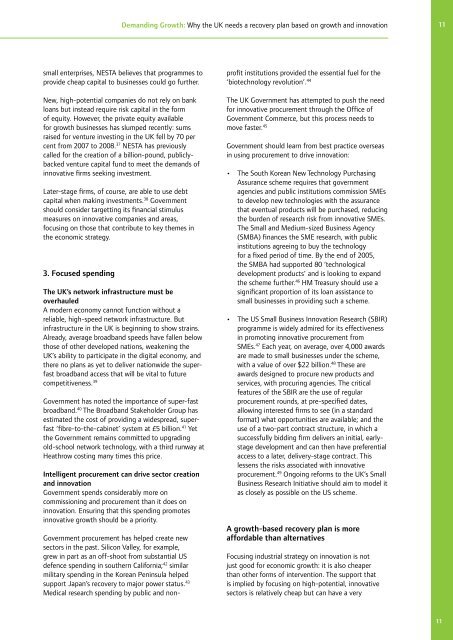Demanding Growth: - University of Brighton Repository
Demanding Growth: - University of Brighton Repository
Demanding Growth: - University of Brighton Repository
Create successful ePaper yourself
Turn your PDF publications into a flip-book with our unique Google optimized e-Paper software.
<strong>Demanding</strong> <strong>Growth</strong>: Why the UK needs a recovery plan based on growth and innovation<br />
small enterprises, NESTA believes that programmes to<br />
provide cheap capital to businesses could go further.<br />
New, high-potential companies do not rely on bank<br />
loans but instead require risk capital in the form<br />
<strong>of</strong> equity. However, the private equity available<br />
for growth businesses has slumped recently: sums<br />
raised for venture investing in the UK fell by 70 per<br />
cent from 2007 to 2008. 37 NESTA has previously<br />
called for the creation <strong>of</strong> a billion-pound, publiclybacked<br />
venture capital fund to meet the demands <strong>of</strong><br />
innovative firms seeking investment.<br />
Later-stage firms, <strong>of</strong> course, are able to use debt<br />
capital when making investments. 38 Government<br />
should consider targetting its financial stimulus<br />
measures on innovative companies and areas,<br />
focusing on those that contribute to key themes in<br />
the economic strategy.<br />
3. Focused spending<br />
The UK’s network infrastructure must be<br />
overhauled<br />
A modern economy cannot function without a<br />
reliable, high-speed network infrastructure. But<br />
infrastructure in the UK is beginning to show strains.<br />
Already, average broadband speeds have fallen below<br />
those <strong>of</strong> other developed nations, weakening the<br />
UK’s ability to participate in the digital economy, and<br />
there no plans as yet to deliver nationwide the superfast<br />
broadband access that will be vital to future<br />
competitiveness. 39<br />
Government has noted the importance <strong>of</strong> super-fast<br />
broadband. 40 The Broadband Stakeholder Group has<br />
estimated the cost <strong>of</strong> providing a widespread, superfast<br />
‘fibre-to-the-cabinet’ system at £5 billion. 41 Yet<br />
the Government remains committed to upgrading<br />
old-school network technology, with a third runway at<br />
Heathrow costing many times this price.<br />
Intelligent procurement can drive sector creation<br />
and innovation<br />
Government spends considerably more on<br />
commissioning and procurement than it does on<br />
innovation. Ensuring that this spending promotes<br />
innovative growth should be a priority.<br />
Government procurement has helped create new<br />
sectors in the past. Silicon Valley, for example,<br />
grew in part as an <strong>of</strong>f-shoot from substantial US<br />
defence spending in southern California; 42 similar<br />
military spending in the Korean Peninsula helped<br />
support Japan’s recovery to major power status. 43<br />
Medical research spending by public and non-<br />
pr<strong>of</strong>it institutions provided the essential fuel for the<br />
‘biotechnology revolution’. 44<br />
The UK Government has attempted to push the need<br />
for innovative procurement through the Office <strong>of</strong><br />
Government Commerce, but this process needs to<br />
move faster. 45<br />
Government should learn from best practice overseas<br />
in using procurement to drive innovation:<br />
• The South Korean New Technology Purchasing<br />
Assurance scheme requires that government<br />
agencies and public institutions commission SMEs<br />
to develop new technologies with the assurance<br />
that eventual products will be purchased, reducing<br />
the burden <strong>of</strong> research risk from innovative SMEs.<br />
The Small and Medium-sized Business Agency<br />
(SMBA) finances the SME research, with public<br />
institutions agreeing to buy the technology<br />
for a fixed period <strong>of</strong> time. By the end <strong>of</strong> 2005,<br />
the SMBA had supported 80 ‘technological<br />
development products’ and is looking to expand<br />
the scheme further. 46 HM Treasury should use a<br />
significant proportion <strong>of</strong> its loan assistance to<br />
small businesses in providing such a scheme.<br />
• The US Small Business Innovation Research (SBIR)<br />
programme is widely admired for its effectiveness<br />
in promoting innovative procurement from<br />
SMEs. 47 Each year, on average, over 4,000 awards<br />
are made to small businesses under the scheme,<br />
with a value <strong>of</strong> over $22 billion. 48 These are<br />
awards designed to procure new products and<br />
services, with procuring agencies. The critical<br />
features <strong>of</strong> the SBIR are the use <strong>of</strong> regular<br />
procurement rounds, at pre-specified dates,<br />
allowing interested firms to see (in a standard<br />
format) what opportunities are available; and the<br />
use <strong>of</strong> a two-part contract structure, in which a<br />
successfully bidding firm delivers an initial, earlystage<br />
development and can then have preferential<br />
access to a later, delivery-stage contract. This<br />
lessens the risks associated with innovative<br />
procurement. 49 Ongoing reforms to the UK’s Small<br />
Business Research Initiative should aim to model it<br />
as closely as possible on the US scheme.<br />
A growth-based recovery plan is more<br />
affordable than alternatives<br />
Focusing industrial strategy on innovation is not<br />
just good for economic growth: it is also cheaper<br />
than other forms <strong>of</strong> intervention. The support that<br />
is implied by focusing on high-potential, innovative<br />
sectors is relatively cheap but can have a very<br />
11<br />
11

















